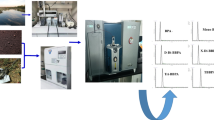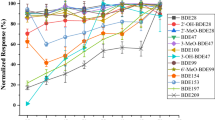Abstract
Bisphenol A (BPA) and its brominated analogs exhibiting bioaccumulation potential, endocrine disruption, and reproductive toxicity have been worldwide detected in water, air, soil, and sediments. But few methods have been proposed for simultaneously determining a variety of these compounds in biological matrices, hindering the further study on their biological transformation/degradation and health risks. In this study, a simple, solvent-saving and sensitive method based on high-performance thin-layer chromatography (HPTLC) for sample pretreatment coupled with high-performance liquid chromatography-diode array detector (HPLC-DAD) (UV = 214 nm)/triple quadrupole mass spectrometry (MS/MS) was developed for determining BPA and its nine brominated analogs in biological samples. The method detection limits (MDLs) and method quantification limits (MQLs) for ten BPA analogs ranged from 0.8 to 685.7 ng g−1 dw (S/N = 3) and 2.7 to 2285.7 ng g−1 dw (S/N = 10), respectively. The recoveries were 64–124% with SD less than 10%. The RSD of intermediate precision was less than 11%, and matrix effects were lower than 19%. Compared with traditional purification procedures, HPTLC largely reduced the workload and procedures for complex biological sample cleanup without inducing decomposition of the analytes. The proposed method exhibited good performance when detecting these ten chemicals in chicken samples from a nearby yard of brominated flame retardant plants, indicating its great potential for investigating their environment level, behavior, and fate in organisms.

ᅟ



Similar content being viewed by others
References
Covaci A, Harrad S, Abdallah MAE, Ali N, Law RJ, Herzke D, et al. Novel brominated flame retardants: a review of their analysis, environmental fate and behaviour. Environ Int. 2011;37(2):532–56.
Covaci A, Voorspoels S, Abou-Elwafa Abdallah M, Geens T, Harrad S, Law RJ. Analytical and environmental aspects of the flame retardant tetrabromobisphenol-A and its derivatives. J Chromatogr A. 2009;1216(3):346–63.
Zhu NL, Li A, Wang T, Wang P, Qu GB, Ruan T, et al. Tris(2,3-dibromopropyl) Isocyanurate, hexabromocyclododecanes, and polybrominated diphenyl ethers in mollusks from Chinese Bohai Sea. Environ Sci Technol. 2012;46(13):7174–81. https://doi.org/10.1021/es300776f.
Liu L, Venier M, Salamova A, Hites RA. A novel flame retardant in the Great Lakes atmosphere: 3,3′,5,5′-tetrabromobisphenol A bis(2,3-dibromopropyl) ether. Environ Sci Technol. 2016;3(5):194–9. https://doi.org/10.1021/acs.estlett.6b00138.
Ali N, Harrad S, Goosey E, Neels H, Covaci A. “Novel” brominated flame retardants in Belgian and UK indoor dust: implications for human exposure. Chemosphere. 2011;83(10):1360–5. https://doi.org/10.1016/j.chemosphere.2011.02.078.
Gauthier LT, Potter D, Hebert CE, Letcher RJ. Temporal trends and spatial distribution of non-polybrominated diphenyl ether flame retardants in the eggs of colonial populations of Great Lakes herring gulls. Environ Sci Technol. 2008;43(2):312–7. https://doi.org/10.1021/es801687d.
Liu L, Liu A, Zhang Q, Shi J, He B, Yun Z, et al. Determination of tetrabromobisphenol-A/S and their main derivatives in water samples by high performance liquid chromatography coupled with inductively coupled plasma tandem mass spectrometry. J Chromatogr A. 2017;1497:81–6. https://doi.org/10.1016/j.chroma.2017.03.040.
Liu A, Shi J, Qu G, Hu L, Ma Q, Song M, et al. Identification of emerging brominated chemicals as the transformation products of tetrabromobisphenol A (TBBPA) derivatives in soil. Environ Sci Technol. 2017. https://doi.org/10.1021/acs.est.7b01071.
Liu A, Qu G, Yu M, Liu Y, Shi J, Jiang G. Tetrabromobisphenol-A/S and nine novel analogs in biological samples from the Chinese Bohai Sea: implications for trophic transfer. Environ Sci Technol. 2016;50(8):4203–11. https://doi.org/10.1021/acs.est.5b06378.
Liu A, Qu G, Zhang C, Gao Y, Shi J, Du Y, et al. Identification of two novel brominated contaminants in water samples by ultra-high performance liquid chromatography-Orbitrap fusion Tribrid mass spectrometer. J Chromatogr A. 2015;1377:92–9. https://doi.org/10.1016/j.chroma.2014.12.038.
Hites RA. Polybrominated diphenyl ethers in the environment and in people: a meta-analysis of concentrations. Environ Sci Technol. 2004;38(4):945–56.
Letcher RJ, Chu S. High-sensitivity method for determination of tetrabromobisphenol-S and tetrabromobisphenol-A derivative flame retardants in Great Lakes herring gull eggs by liquid chromatography-atmospheric pressure photoionization-tandem mass spectrometry. Environ Sci Technol. 2010;44(22):8615–21. https://doi.org/10.1021/es102135n.
Tian Y, Liu A, Qu G, Liu C, Chen J, Handberg E, et al. Silver ion post-column derivatization electrospray ionization mass spectrometry for determination of tetrabromobisphenol A derivatives in water samples. RSC Adv. 2015;5(23):17474–81. https://doi.org/10.1039/C4RA16166A.
Qu G, Shi J, Wang T, Fu J, Li Z, Wang P, et al. Identification of tetrabromobisphenol A diallyl ether as an emerging neurotoxicant in environmental samples by bioassay-directed fractionation and HPLC-APCI-MS/MS. Environ Sci Technol. 2011;45(11):5009–16. https://doi.org/10.1021/Es2005336.
Zhang H, Bayen S, Kelly BC. Co-extraction and simultaneous determination of multi-class hydrophobic organic contaminants in marine sediments and biota using GC-EI-MS/MS and LC-ESI-MS/MS. Talanta. 2015;143:7–18. https://doi.org/10.1016/j.talanta.2015.04.084.
Deceuninck Y, Bichon E, Durand S, Bemrah N, Zendong Z, Morvan ML, et al. Development and validation of a specific and sensitive gas chromatography tandem mass spectrometry method for the determination of bisphenol A residues in a large set of food items. J Chromatogr A. 2014;1362:241–9. https://doi.org/10.1016/j.chroma.2014.07.105.
Cunha SC, Oliveira C, Fernandes JO. Development of QuEChERS-based extraction and liquid chromatography-tandem mass spectrometry method for simultaneous quantification of bisphenol A and tetrabromobisphenol A in seafood: fish, bivalves, and seaweeds. Anal Bioanal Chem. 2017;409(1):151–60. https://doi.org/10.1007/s00216-016-9980-3.
Abdallah MA, Harrad S, Covaci A. Isotope dilution method for determination of polybrominated diphenyl ethers using liquid chromatography coupled to negative ionization atmospheric pressure photoionization tandem mass spectrometry: validation and application to house dust. Anal Chem. 2009;81(17):7460–7.
Liu J, Wang Y, Jiang B, Wang L, Chen J, Guo H, et al. Degradation, metabolism, and bound-residue formation and release of tetrabromobisphenol A in soil during sequential anoxic–oxic incubation. Environ Sci Technol. 2013;47(15):8348–54. https://doi.org/10.1021/es4014322.
Li F, Wang J, Nastold P, Jiang B, Sun F, Zenker A, et al. Fate and metabolism of tetrabromobisphenol A in soil slurries without and with the amendment with the alkylphenol degrading bacterium Sphingomonas sp strain TTNP3. Environ Pollut. 2014;193:181–8. https://doi.org/10.1016/j.envpol.2014.06.030.
Liu A, Shi J, Qu G, Hu L, Ma Q, Song M, et al. Identification of emerging brominated chemicals as the transformation products of tetrabromobisphenol A (TBBPA) derivatives in soil. Environ Sci Technol. 2017;51(10):5434–44. https://doi.org/10.1021/acs.est.7b01071.
Fini J-B, Riu A, Debrauwer L, Hillenweck A, Le Mevel S, Chevolleau S, et al. Parallel biotransformation of tetrabromobisphenol A in Xenopus laevis and mammals: Xenopus as a model for endocrine perturbation studies. Toxicol Sci. 2012;125(2):359–67. https://doi.org/10.1093/toxsci/kfr312.
Hou X, Yu M, Liu A, Li Y, Ruan T, Liu J, et al. Biotransformation of tetrabromobisphenol A dimethyl ether back to tetrabromobisphenol A in whole pumpkin plants. Environ Pollut. 2018;241:331–8. https://doi.org/10.1016/j.envpol.2018.05.075.
Han SK, Yamasaki T, Yamada K-I. Photodecomposition of tetrabromobisphenol A in aqueous humic acid suspension by irradiation with light of various wavelengths. Chemosphere. 2016;147:124–30. https://doi.org/10.1016/j.chemosphere.2015.12.072.
Wang S, Cao S, Wang Y, Jiang B, Wang L, Sun F, et al. Fate and metabolism of the brominated flame retardant tetrabromobisphenol A (TBBPA) in rice cell suspension culture. Environ Pollut. 2016;214:299–306. https://doi.org/10.1016/j.envpol.2016.04.037.
Köppen R, Becker R, Jung C, Piechotta C, Nehls PI. Investigation of extraction procedures and HPLC-DAD/MS for the determination of the brominated flame retardant tetrabromobisphenol A bis(2,3-dibromopropylether) in environmental samples. Anal Bioanal Chem. 2006;384(7–8):1485–92.
Shi T, Chen S, Luo X, Zhang X, Tang C, Luo Y, et al. Occurrence of brominated flame retardants other than polybrominated diphenyl ethers in environmental and biota samples from southern China. Chemosphere. 2009;74(7):910–6.
Nyholm JR, Norman A, Norrgren L, Haglund P, Andersson PL. Maternal transfer of brominated flame retardants in zebrafish (Danio rerio). Chemosphere. 2008;73(2):203–8. https://doi.org/10.1016/j.chemosphere.2008.04.033.
Law RJ, Bersuder P, Allchin CR, Barry J. Levels of the flame retardants hexabromocyclododecane and tetrabromobisphenol A in the blubber of harbor porpoises (Phocoena phocoena) stranded or bycaught in the UK, with evidence for an increase in HBCD concentrations in recent years. Environ Sci Technol. 2006;40(7):2177–83. https://doi.org/10.1021/es052416o.
Qu G, Liu A, Hu L, Liu S, Shi J, Jiang G. Recent advances in the analysis of TBBPA/TBBPS, TBBPA/TBBPS derivatives and their transformation products. TrAC-Trend Anal Chem. 2016;83(Part B):14–24. https://doi.org/10.1016/j.trac.2016.06.021.
Zhong Y, Li D, Mao Z, Huang W, Peng PA, Chen P, et al. Kinetics of tetrabromobisphenol A (TBBPA) reactions with H2SO4, HNO3 and HCl: implication for hydrometallurgy of electronic wastes. J Hazard Mater. 2014;270:196–201. https://doi.org/10.1016/j.jhazmat.2014.01.032.
Patel AA, Amin AA, Patwari AH, Shah MB. Validated high performance thin layer chromatography method for simultaneous determination of quercetin and gallic acid in Leea indica. Rev Bras Farmacogn. 2017;27(1):50–3. https://doi.org/10.1016/j.bjp.2016.05.017.
Guzelmeric E, Ristivojević P, Vovk I, Milojković-Opsenica D, Yesilada E. Quality assessment of marketed chamomile tea products by a validated HPTLC method combined with multivariate analysis. J Pharm Biomed Anal. 2017;132:35–45. https://doi.org/10.1016/j.jpba.2016.09.030.
Dawan P, Satarpai T, Tuchinda P, Shiowatana J, Siripinyanond A. A simple analytical platform based on thin-layer chromatography coupled with paper-based analytical device for determination of total capsaicinoids in chilli samples. Talanta. 2017;162:460–5. https://doi.org/10.1016/j.talanta.2016.10.077.
Guzelmeric E, Vovk I, Yesilada E. Development and validation of an HPTLC method for apigenin 7-O-glucoside in chamomile flowers and its application for fingerprint discrimination of chamomile-like materials. J Pharm Biomed Anal. 2015;107:108–18. https://doi.org/10.1016/j.jpba.2014.12.021.
Loescher CM, Morton DW, Razic S, Agatonovic-Kustrin S. High performance thin layer chromatography (HPTLC) and high performance liquid chromatography (HPLC) for the qualitative and quantitative analysis of Calendula officinalis—advantages and limitations. J Pharm Biomed Anal. 2014;98:52–9. https://doi.org/10.1016/j.jpba.2014.04.023.
Renger B, Végh Z, Ferenczi-Fodor K. Validation of thin layer and high performance thin layer chromatographic methods. J Chromatogr A. 2011;1218(19):2712–21.
Ferenczifodor K, Renger B, Végh Z. The frustrated reviewer—recurrent failures in manuscripts describing validation of quantitative TLC/HPTLC procedures for analysis of pharmaceuticals. J Planar Chromat. 2010;23(3):173–9.
Witos YA, Milz B, Spangenberg B. Two-dimensional thin-layer chromatography of 17α-ethinylestradiol on RP-18 W plate, detected by effect-directed analysis using the YES test. J Planar Chromat. 2017;30(2):136–41. https://doi.org/10.1556/1006.2017.30.2.8.
Kokotkiewicz A, Migas P, Stefanowicz J, Luczkiewicz M, Krauze-Baranowska M. Densitometric TLC analysis for the control of tropane and steroidal alkaloids in Lycium barbarum. Food Chem. 2017;221:535–40. https://doi.org/10.1016/j.foodchem.2016.11.142.
Qu G, Liu A, Wang T, Zhang C, Fu J, Yu M, et al. Identification of tetrabromobisphenol A allyl ether and tetrabromobisphenol A 2,3-dibromopropyl ether in the ambient environment near a manufacturing site and in mollusks at a coastal region. Environ Sci Technol. 2013;47(9):4760–7. https://doi.org/10.1021/es3049916.
George KW, Haeggblom MM. Microbial O-methylation of the flame retardant tetrabromobisphenol-A. Environ Sci Technol. 2008;42(15):5555–61. https://doi.org/10.1021/es800038q.
Nakao T, Akiyama E, Kakutani H, Mizuno A, Aozasa O, Akai Y, et al. Levels of tetrabromobisphenol A, tribromobisphenol A, dibromobisphenol A, monobromobisphenol A, and bisphenol A in Japanese breast milk. Chem Res Toxicol. 2015;28(4):722–8. https://doi.org/10.1021/tx500495j.
Liu A, Shen Z, Tian Y, Shi R, Liu Y, Zhao Z, et al. Thin-layer chromatography coupled with high performance liquid chromatography for determining tetrabromobisphenol A/S and their derivatives in soils. J Chromatogr A. 2017;1526(Supplement C):151–6. https://doi.org/10.1016/j.chroma.2017.10.045.
Abou-Elwafa AM. Environmental occurrence, analysis and human exposure to the flame retardant tetrabromobisphenol-A (TBBP-A)—a review. Environ Int. 2016;94:235–50. https://doi.org/10.1016/j.envint.2016.05.026.
Akiyama E, Kakutani H, Nakao T, Motomura Y, Takano Y, Sorakubo R, et al. Facilitation of adipocyte differentiation of 3T3-L1 cells by debrominated tetrabromobisphenol A compounds detected in Japanese breast milk. Environ Res. 2015;140:157–64. https://doi.org/10.1016/j.envres.2015.03.035.
Chu SG, Haffner GD, Letcher RJ. Simultaneous determination of tetrabromobisphenol A, tetrachlorobisphenol A, bisphenol A and other halogenated analogues in sediment and sludge by high performance liquid chromatography-electrospray tandem mass spectrometry. J Chromatogr A. 2005;1097(1–2):25–32. https://doi.org/10.1016/j.chroma.2005.08.007.
Funding
This work was supported by the National Natural Science Foundation of China (21707148), the China Postdoctoral Science Foundation (2016M602210 and 2018T110715) and the Open Fund supported by the State Key Laboratory of Environmental Chemistry and Ecotoxicology, Research Center for Eco-Environmental Sciences, Chinese Academy of Sciences (KF2016-12).
Author information
Authors and Affiliations
Corresponding author
Ethics declarations
Ethical approval
All procedures performed in studies involving animals were in accordance with the ethical standards of the care and use of animals in china. The studies have been approved by the Academic Committee (Ethics Committee) of Qingdao Institute of Bioenergy and Bioprocess Technology, China Academy of Sciences.
Conflict of interest
The authors declare that they have no conflict of interest.
Additional information
Publisher’s Note
Springer Nature remains neutral with regard to jurisdictional claims in published maps and institutional affiliations.
Electronic supplementary material
ESM 1
(PDF 195 kb)
Rights and permissions
About this article
Cite this article
Liu, A., Shen, Z., Yuan, L. et al. High-performance thin-layer chromatography coupled with HPLC-DAD/HPLC-MS/MS for simultaneous determination of bisphenol A and nine brominated analogs in biological samples. Anal Bioanal Chem 411, 725–734 (2019). https://doi.org/10.1007/s00216-018-1492-x
Received:
Revised:
Accepted:
Published:
Issue Date:
DOI: https://doi.org/10.1007/s00216-018-1492-x




